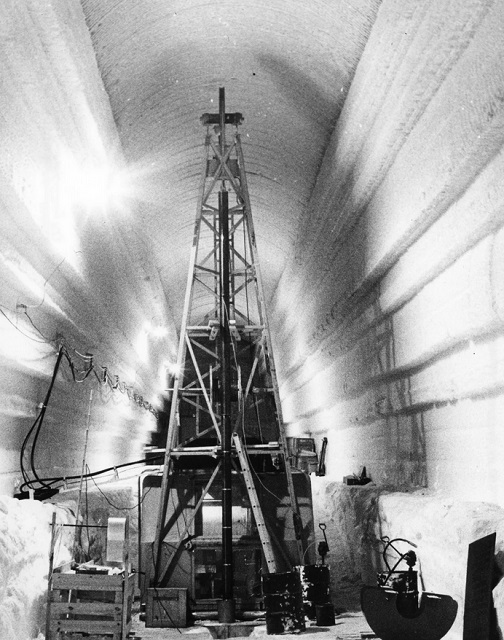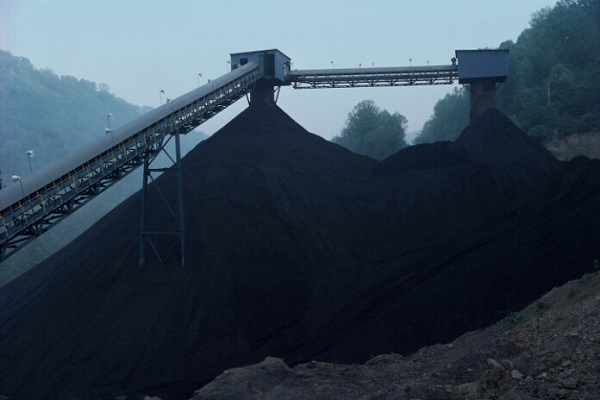Economy
Abandoned Greenland ice base calls co2 concerns into question

Wired.com had another story with a climate change hook on July 20 called, “An Abandoned Arctic Military Base Just Spilled a Scientific Secret.” It began “During the Cold War, the US built a network of tunnels in the Greenland ice sheet. Sixty years later, the base has provided a critical clue about the climate crisis.”
From 1959 to 1966, Project Iceworm in Greenland was meant to establish military bases in caverns carved out of glacial ice, with Camp Century being the trial run. The plan was to locate as many as 600 intercontinental ballistic missiles in under-ice caverns, invisible to the Soviets, and within striking range of the USSR.
However, the project never did work out and it was terminated in 1966.
The climate angle comes out of what was discovered in remarkable ice core the military drilled through the glacier.
The Wired article said that researchers drilled a 4,550-foot-deep core through the ice sheet, and when they hit earth, they drilled another 12 feet, bringing up a plug of frozen sand, dirty ice, cobbles, and mud.
It continued, “Nobody cared much about the sediment, though, until 2018, when it was rediscovered in … a University of Copenhagen freezer.” Now, an international team of researchers has analyzed that sediment, and made a major scientific discovery.
“In that frozen sediment are leaf fossils and little bits of bugs and twigs and mosses that tell us in the past there was a tundra ecosystem living where today there’s almost a mile of ice,” says University of Vermont geoscientist Paul Bierman, coauthor of a new paper describing the finding in the journal Science. “The ice sheet is fragile. It can disappear, and it has disappeared. Now we have a date for that.”
Wired wrote, “Previously, scientists reckoned that Greenland iced over some 2.5 million years ago, and has been that way since. In 2021, Bierman and his colleagues determined that it was actually ice-free sometime in the past million years. Now, they’ve dated the tundra ecosystem captured in the Camp Century core to a mere 416,000 years ago—so northwestern Greenland couldn’t have been locked in ice then.”
And here’s where the mental gymnastics take place: Scientists also know that at that time, global temperatures were similar or slightly warmer than what they are today. However, back then, atmospheric concentrations of planet-warming carbon dioxide were about 280 parts per million, compared to today’s 422 parts per million—a number that continues to skyrocket.”
The article continued, “Because humans have so dramatically and rapidly warmed the climate, we’re exceeding the conditions that had previously led to the wide-scale melting of Greenland’s ice sheet and gave rise to the tundra ecosystem. “It’s a forewarning,” says Utah State University geoscientist Tammy Rittenour, a coauthor of the new paper. “This can happen under much lower CO2 conditions than our current state.”
Whoa, there, Nelly! You’re telling me that carbon dioxide levels were a full third less than they are today, and yet the northernmost portions of Greenland (the most likely to freeze) was tundra? Greenland did not have the better part of a mile of ice covering it when CO2 was well below the supposedly crucial threshold of 350 parts per million?
Indeed, the article goes on to say, “That melting [of all the Greenland ice] could be incredibly perilous. The new study finds that the Greenland ice melt 400,000 years ago caused at least 5 feet of sea level rise, but perhaps as much as 20 feet. “These findings raise additional concern that we could be coming perilously close to the threshold for collapse of the Greenland ice sheet and massive additional sea level rise of a meter or more,” says University of Pennsylvania climate scientist Michael Mann, who wasn’t involved in the research. Today, less than a foot of global sea level rise is already causing serious flooding and storm surge problems for coastal cities—and that’s without the potential for an additional 20 feet.”
Again, look at the claim: carbon dioxide levels were much lower, sea levels were much higher, and the Greenland ice sheet was much smaller.
This new evidence makes reasonable people wonder if there truly is a link between carbon dioxide levels, global warming, and disappearance of ice sheets. How could so much ice be gone, melted into the ocean, with such a low CO2 level?
Surely something here doesn’t jive. And yet the world is in a tizzy over rising carbon dioxide levels.
Maybe someone should go back to Greenland, and drill a few more core samples to test this theory before we destroy our economy and our lives.
Perhaps the science of climate change isn’t settled after all.
Brian Zinchuk is editor and owner of Pipeline Online, and occasional contributor to the Frontier Centre for Public Policy. He can be reached at [email protected]. First published here.
Automotive
Governments in Canada accelerate EV ‘investments’ as automakers reverse course

From the Fraser Institute
Evidence continues to accrue that many of these “investments,” which are ultimately of course taxpayer funded, are risky ventures indeed.
Even as the much-vaunted electric vehicle (EV) transition slams into stiff headwinds, the Trudeau government and Ontario’s Ford government will pour another $5 billion in subsidies into Honda, which plans to build an EV battery plant and manufacture EVs in Ontario.
This comes on top of a long list of other such “investments” including $15 billion for Stellantis and LG Energy Solution, $13 billion for Volkswagen (with a real cost to Ottawa of $16.3 billion, per the Parliamentary Budget Officer), a combined $4.24 billion (federal/Quebec split) to Northvolt, a Swedish battery maker, and a combined $644 million (federal/Quebec split) to Ford Motor Company to build a cathode manufacturing plant in Quebec.
All this government subsidizing is of course meant to help remake the automobile, with the Trudeau government mandating that 100 per cent of new passenger vehicles and light trucks sold in Canada be zero-emission by 2035. But evidence continues to accrue that many of these “investments,” which are ultimately of course taxpayer funded, are risky ventures indeed.
As the Wall Street Journal notes, Tesla, the biggest EV maker in the United States, has seen its share prices plummet (down 41 per cent this year) as the company struggles to sell its vehicles at the pace of previous years when first-adopters jumped into the EV market. Some would-be EV makers or users are postponing their own EV investments. Ford has killed it’s electric F-150 pickup truck, Hertz is dumping one-third of its fleet of EV rental vehicles, and Swedish EV company Polestar dropped 15 per cent of its global work force while Tesla is cutting 10 per cent of its global staff.
And in the U.S., a much larger potential market for EVs, a recent Gallup poll shows a market turning frosty. The percentage of Americans polled by Gallup who said they’re seriously considering buying an EV has been declining from 12 per cent in 2023 to 9 per cent in 2024. Even more troubling for would-be EV sellers is that only 35 per cent of poll respondents in 2024 said they “might consider” buying an EV in the future. That number is down from 43 per cent in 2023.
Overall, according to Gallup, “less than half of adults, 44 per cent, now say they are either seriously considering or might consider buying an EV in the future, down from 55 per cent in 2023, while the proportion not intending to buy one has increased from 41 per cent to 48 per cent.” In other words, in a future where government wants sellers to only sell EVs, almost half the U.S. public doesn’t want to buy one.
And yet, Canada’s governments are hitting the gas pedal on EVs, putting the hard-earned capital of Canadian taxpayers at significant risk. A smart government would have its finger in the wind and would slow down when faced with road bumps. It might even reset its GPS and change the course of its 2035 EV mandate for vehicles few motorists want to buy.
Author:
Automotive
Red States Sue California and the Biden Administration to Halt Electric Truck Mandates

From Heartland Daily News
By Nick Pope
“California and an unaccountable EPA are trying to transform our national trucking industry and supply chain infrastructure. This effort—coming at a time of heightened inflation and with an already-strained electrical grid—will devastate the trucking and logistics industry, raise prices for customers, and impact untold number of jobs across Nebraska and the country”
Large coalitions of red states are suing regulators in Washington, D.C., and California over rules designed to effectively require increases in electric vehicle (EV) adoption.
Nebraska is leading a 24-state coalition in a lawsuit against the Environmental Protection Agency’s (EPA) recently-finalized emissions standards for heavy-duty vehicles in the U.S. Court of Appeals for the D.C. Circuit, and a 17-state coalition suing the state of California in the U.S. District Court for the Eastern District of California over its Advanced Clean Fleet rules. Both regulations would increase the number of heavy-duty EVs on the road, a development that could cause serious disruptions and cost increases across the U.S. economy, as supply chain and trucking sector experts have previously told the Daily Caller News Foundation.
“California and an unaccountable EPA are trying to transform our national trucking industry and supply chain infrastructure. This effort—coming at a time of heightened inflation and with an already-strained electrical grid—will devastate the trucking and logistics industry, raise prices for customers, and impact untold number of jobs across Nebraska and the country,” Republican Nebraska Attorney General Mike Hilgers said in a statement. “Neither California nor the EPA has the constitutional power to dictate these nationwide rules to Americans. I am proud to lead our efforts to stop these unconstitutional attempts to remake our economy and am grateful to our sister states for joining our coalitions.”
(RELATED: New Analysis Shows Just How Bad Electric Trucks Are For Business)
While specifics vary depending on the type of heavy-duty vehicle, EPA’s emissions standards will effectively mandate that EVs make up 60% of new urban delivery trucks and 25% of long-haul tractors sold by 2032, according to The Wall Street Journal. The agency has also pushed aggressive emissions standards for light- and medium-duty vehicles that will similarly force an increase in EVs’ share of new car sales over the next decade.
California’s Advanced Clean Fleet rules, meanwhile, will require that 100% of trucks sold in the state will be zero-emissions models starting in 2036, according to the California Air Resources Board (CARB). While not federal, the California rules are of importance to other states because there are numerous other states who follow California’s emissions standards, which can be tighter than those required by the EPA and other federal agencies.
Critics fear that this dynamic will effectively enable California to set national policies and nudge manufacturers in the direction of EVs at a greater rate and scale than the Biden administration is pursuing.
Trucking industry and supply chain experts have previously told the DCNF that both regulations threaten to cause serious problems for the country’s supply chains and wider economy given that the technology for electric and zero-emissions trucks is simply not yet ready to be mandated at scale, among other issues.
Neither CARB nor the EPA responded immediately to requests for comment.
Nick Pope is a contributor to The Daily Caller News Service.
Originally published by The Daily Caller. Republished with permission.
-

 Uncategorized2 days ago
Uncategorized2 days agoRCMP recruitment failure has Alberta advocacy group calling for Provincial Police Service
-

 Automotive19 hours ago
Automotive19 hours agoGovernments in Canada accelerate EV ‘investments’ as automakers reverse course
-

 COVID-191 day ago
COVID-191 day agoJapan’s most senior cancer doctor: COVID shots are ‘essentially murder’
-

 Health2 days ago
Health2 days agoPrivate Footage Reveals Leading Medical Org’s Efforts To ‘Normalize’ Gender Ideology
-

 Health12 hours ago
Health12 hours agoSouth Korean president declares low birth rate a ‘national emergency,’ plans new ministry to address it
-

 Economy22 hours ago
Economy22 hours agoBiden signs suicidal ‘No Coal’ pact, while rest of world builds 1,000 new plants
-

 Health2 days ago
Health2 days agoTHE WPATH TAPES: Behind-The-Scenes Recordings Reveal What Top Gender Doctors Really Think About Sex Change Procedures
-

 COVID-192 days ago
COVID-192 days agoTrudeau government only sought legal advice after Emergencies Act was invoked, records indicate








